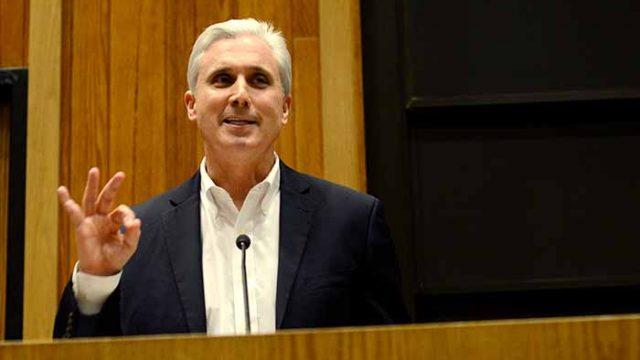Boston College’s offices of News and Public Affairs and Marketing Communication will merge this semester. The new office will be called the Office of University Communications.
According to University Spokesman Jack Dunn, the goal in restructuring the NPA and the OMC is to form a single office that will combine the University’s communication operations to work cooperatively and effectively. The new office will be located in the OMC’s current location at 3 Lake Street on the Brighton Campus.
Dunn will take over the new office as the associate vice president for university communications.
The Office of University Communications will integrate the responsibilities of the NPA and the OMC. The duties of the NPA currently include the publication of The Chronicle, conducting relations with the media, managing social media, creating promotional videos, and overseeing the redesign of the University’s website. The OMC is responsible for marketing communications, creating graphic designs, and managing other aspects of social media and promotional publications, as well as photography. The OMC also houses Boston College Magazine.
“I think it can only be an improvement,” said Ben Birnbaum, the executive director of the OMC and editor of Boston College Magazine.
Currently, the NPA deals more with external issues, while the OMC works internally within the University, Birnbaum said. He said that in the past, however, the offices’ job descriptions were more distinguished.
The NPA used to be primarily concerned with public relations issues and dealing with the press. NPA representatives were responsible for encouraging news outlets to publish stories favorable to the University, Birnbaum said. Alternatively, OMC was focused on paper records, like pamphlets and magazines, that would promote the University’s mission.
With the advent of social media, however, the offices’ job descriptions have become more aligned, Birnbaum said. In recent years, they have worked on similar projects, like working with University Admissions to promote BC to prospective students.
“This is a much more complex business now,” Birnbaum said.
“The trend in higher education has been to integrate communications functions to achieve maximum productivity.”
—Jack Dunn, University Spokesman
The decision to converge the offices was made after Birnbaum requested to step down to a part-time position. He will now work as a senior adviser to Leahy. Birnbaum has worked in the OMC for 38 years, serving as executive director since 1992. Birnbaum has not been involved with the restructuring process thus far.
Prior to 1992, BC had one Office of Communications that dealt with marketing and public relations on campus. When Doug Whiting, the director of the Office of Communications at the time, stepped down in 1991, Birnbaum was promoted to his position. According to The Heights’s archives, there was talk of restructuring the office into two separate departments, the NPA and the OMC, in 1991.
When the University split the office into two departments, Birnbaum was given his current position, director of the Office of Marketing Communications. Robert Kaiser was given the position as the director of the Office of Public Affairs. Birnbaum said that the University’s reason for splitting the two offices in 1992 was to accommodate leadership positions for both Birnbaum and Kaiser.
At Boston University, communications efforts are overseen by the larger department of External Affairs. BU’s offices of Public Relations, Marketing Communications, Government and Community Affairs, and Federal Relations all operate separately from one another, although they work cooperatively under External Affairs.
Northeastern University divides its communication responsibilities between the offices of Marketing and Communications and Government Relations, which are also organized under the overarching title of External Affairs.
Harvard University, according to Birnbaum, has a long tradition of distributing functions across the University. Harvard separates several departments into separate entities, including communications. Its office of Public Affairs and Communications is composed of its Office of Federal Relations, as well as its staff that focuses on community and state affairs and relations. All of Harvard’s individual schools also include their own communications offices.
According to Birnbaum and Dunn, however, most universities across the country run with one combined office, rather than holding marketing and public relations in two separate departments.
“The trend in higher education has been to integrate communications functions to achieve maximum productivity,” Dunn said in an email.
Featured Image by Drew Hoo / Heights Editor



















